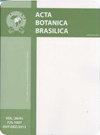巴西东北部半干旱地区蜂花粉的花粉剖面
IF 1.1
4区 生物学
Q4 PLANT SCIENCES
引用次数: 0
摘要
巴西东北部有不同生物群系的干旱植被。它的植物异质性为各种动物提供了庇护所。该地区有丰富的蜜蜂,它们需要植物提供的资源,并提供授粉服务。蜂花粉因其高营养成分和天然抗氧化剂而被用作人类有益的食物来源。花粉分析可以确定蜜蜂访问的植物种类,并将其作为花粉供应来源。本研究旨在鉴定巴西东北部蜜蜂花粉中存在的主要花粉类型,并确定其植物亲和性。该地区生产的商业蜂花粉样品经乙酰解法处理,装在载玻片上,并估计每种花粉的发生频率。共鉴定出113种花粉类型,隶属于35科92属。豆科和菊科是对花粉类型贡献最大的科。在50%以上的样品中发现了椰子和桃金娘的花粉类型。槟榔科和豆科具有较高的养蜂潜力。来自伯南布哥州和北里奥格兰德州的花粉样本有惊人的相似之处。本文章由计算机程序翻译,如有差异,请以英文原文为准。
Pollen profile of bee pollen from semiarid Northeastern Brazil
The Northeastern Brazil has xerical vegetation with different biomes. Its botanical heterogeneity represents shelter for diverse fauna. The region is rich in bees, which demand the resources offered by the plants, and provide pollination services. Bee pollen has been used as a beneficial food source for humans due to its high nutritional content and being a natural antioxidant. Pollen analysis can determine the plant species visited by bees, using them as the source of pollen supply. This study aimed to identify the main pollen types present in the pollen collected by Apis mellifera in the Northeastern Brazil and to define its botanical affinity. Commercial bee pollen samples produced in the region were treated by acetolysis method, mounted on slides, and the frequency of occurrence was estimated for each type of pollen. It was possible to distinguish 113 pollen types belonging to 35 botanical families, distributed in 92 genera. Fabaceae and Asteraceae were the families that most contributed to pollen types. Pollen types of Cocos nucifera and Myrcia were found in more than 50% of the samples. The families Arecaceae and Fabaceae showed high beekeeping potential. There is a striking similarity between the pollen samples from the states of Pernambuco and Rio Grande Norte.
求助全文
通过发布文献求助,成功后即可免费获取论文全文。
去求助
来源期刊

Acta Botanica Brasilica
PLANT SCIENCES-
CiteScore
2.30
自引率
9.10%
发文量
32
审稿时长
6-12 weeks
期刊介绍:
Experimental, theoretical and applied papers on all aspects of plant (including algae) and fungi biology are welcome. The submitted manuscript or its essential content must not have been published previously or be under consideration for publication elsewhere. Contributions should be substantial, written in high-quality English and show general interest. We expect that the submitted manuscript presents a great novelty in Botany, and this should attract a wide audience. Considering this, case studies are only considered if the narrative and implications are provided to be of general interest. Thus, manuscripts that report aspects of local interest are discouraged unless the implications of the findings are wide-reaching. Manuscripts with agronomic subjects are expected to contain a substantial amount of basic plant biology. Please see below some details for specific area.
 求助内容:
求助内容: 应助结果提醒方式:
应助结果提醒方式:


